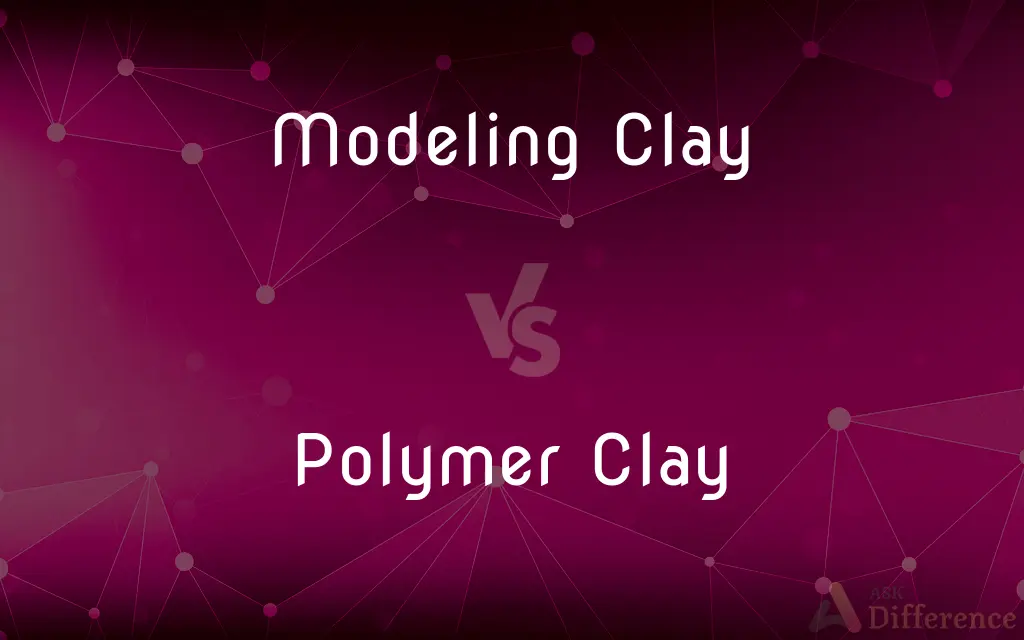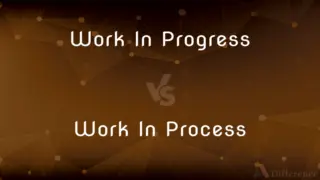Modeling Clay vs. Polymer Clay — What's the Difference?
By Tayyaba Rehman — Published on November 5, 2023
Modeling clay is oil-based and remains malleable, while polymer clay is PVC-based and hardens when baked. Both are used for crafting and sculpting.

Difference Between Modeling Clay and Polymer Clay
Table of Contents
ADVERTISEMENT
Key Differences
Modeling Clay and Polymer Clay are both essential materials in the world of arts and crafts. While both can be shaped and molded, their composition and uses differ substantially. Modeling Clay is primarily oil-based, ensuring it remains soft and pliable. In contrast, Polymer Clay consists of polyvinyl chloride (PVC), which hardens upon baking.
Modeling Clay is often used for creating temporary forms or sculptures that won't be exposed to high temperatures, given its inability to harden like its counterpart. Polymer Clay, however, is a favorite for artists and crafters looking to create permanent and intricate designs, given its durability post-baking.
Another key distinction between Modeling Clay and Polymer Clay is their finish. Modeling Clay tends to have a more matte and earthy appearance, resembling natural clay. On the flip side, Polymer Clay can be found in a variety of colors and finishes, from matte to glossy, making it versatile for jewelry and decorative items.
When handling these clays, their texture differs. Modeling Clay generally has a heavier and waxier feel, while Polymer Clay is lighter and can be conditioned to achieve a smooth consistency.
In summary, while Modeling Clay and Polymer Clay might seem similar at a glance, their properties and uses are distinct. One remains soft and workable, while the other can be baked to a hard finish, each catering to different artistic needs.
ADVERTISEMENT
Comparison Chart
Composition
Oil-based
PVC-based
Hardening Ability
Remains malleable; doesn't harden
Hardens when baked
Appearance
Matte and earthy
Available in various colors and finishes (matte to glossy)
Texture
Heavier, waxier
Lighter, can be conditioned
Primary Use
Temporary forms, sculptures
Permanent crafts, jewelry, decorative items
Compare with Definitions
Modeling Clay
A malleable substance that doesn't harden.
The children shaped the modeling clay into various animals, knowing they could reshape them later.
Polymer Clay
A PVC-based crafting material.
She used polymer clay to craft colorful earrings.
Modeling Clay
Has a matte and natural appearance.
The modeling clay sculpture resembled an ancient artifact due to its earthy finish.
Polymer Clay
Comes in various colors and finishes.
The vast color palette of polymer clay allows for endless creative possibilities.
Modeling Clay
A non-toxic, safe medium for all ages.
Schools often stock up on modeling clay for art classes, as it's safe for kids.
Polymer Clay
Used for durable, permanent crafts.
Artists prefer polymer clay for pieces they intend to sell due to its lasting nature.
Modeling Clay
An oil-based crafting material.
Artists use modeling clay for preliminary sketches of sculptures.
Polymer Clay
Popular for jewelry-making and miniature art.
The miniature food replicas were meticulously crafted using polymer clay.
Modeling Clay
Often used for temporary artistic projects.
The animator used modeling clay to create characters for the stop-motion film.
Polymer Clay
Hardens when baked in an oven.
After sculpting the pendant, she baked the polymer clay, solidifying its form.
Common Curiosities
How do I store unused modeling clay?
Keep modeling clay in a sealed container to maintain its malleability.
Can I paint over modeling clay?
Yes, you can paint over modeling clay, but ensure the paint is compatible.
Does polymer clay shrink after baking?
Polymer clay might have a slight reduction in size, but it's minimal.
How long should I bake polymer clay?
Follow the manufacturer's instructions, but generally 15-30 minutes at 230-265°F.
Can I add textures to modeling clay?
Absolutely, modeling clay can be textured using tools or even everyday objects.
Is polymer clay waterproof once baked?
Yes, once baked, polymer clay is waterproof.
Can I bake modeling clay to harden it?
No, modeling clay remains malleable and doesn't harden when baked.
Can polymer clay be reused after baking?
No, once baked, polymer clay is permanent and can't be re-molded.
Is modeling clay suitable for outdoor sculptures?
Not ideally, as it doesn't harden and might be affected by weather.
Share Your Discovery

Previous Comparison
East Coast Oysters vs. West Coast Oysters
Next Comparison
Work In Progress vs. Work In ProcessAuthor Spotlight
Written by
Tayyaba RehmanTayyaba Rehman is a distinguished writer, currently serving as a primary contributor to askdifference.com. As a researcher in semantics and etymology, Tayyaba's passion for the complexity of languages and their distinctions has found a perfect home on the platform. Tayyaba delves into the intricacies of language, distinguishing between commonly confused words and phrases, thereby providing clarity for readers worldwide.













































